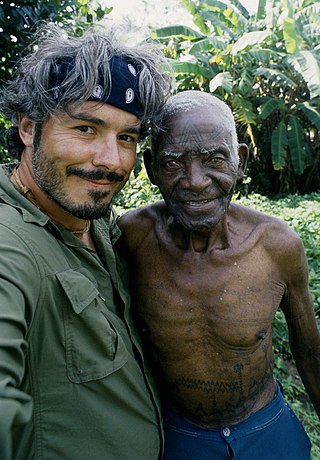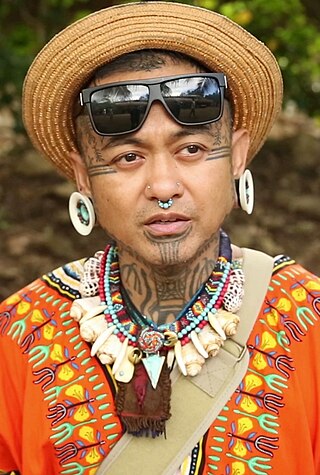
A tattoo is a form of body modification made by inserting tattoo ink, dyes, and/or pigments, either indelible or temporary, into the dermis layer of the skin to form a design. Tattoo artists create these designs using several tattooing processes and techniques, including hand-tapped traditional tattoos and modern tattoo machines. The history of tattooing goes back to Neolithic times, practiced across the globe by many cultures, and the symbolism and impact of tattoos varies in different places and cultures.

The indigenous peoples of the Cordillera in northern Luzon, Philippines, often referred to by the exonym Igorot people, or more recently, as the Cordilleran peoples, are an ethnic group composed of nine main ethnolinguistic groups whose domains are in the Cordillera Mountain Range, altogether numbering about 1.8 million people in the early 21st century.
Jonathan Lindsay Penner is an American actor, screenwriter, television personality, and film producer, known for producing and starring in the film The Last Supper, as well as acting in the television series Rude Awakening and The Naked Truth. He is also known for his multiple appearances on the American competitive reality series Survivor.

Tattooing has been practiced across the globe since at least Neolithic times, as evidenced by mummified preserved skin, ancient art and the archaeological record. Both ancient art and archaeological finds of possible tattoo tools suggest tattooing was practiced by the Upper Paleolithic period in Europe. However, direct evidence for tattooing on mummified human skin extends only to the 4th millennium BC. The oldest discovery of tattooed human skin to date is found on the body of Ötzi the Iceman, dating to between 3370 and 3100 BC. Other tattooed mummies have been recovered from at least 49 archaeological sites, including locations in Greenland, Alaska, Siberia, Mongolia, western China, Egypt, Sudan, the Philippines and the Andes. These include Amunet, Priestess of the Goddess Hathor from ancient Egypt, multiple mummies from Siberia including the Pazyryk culture of Russia and from several cultures throughout Pre-Columbian South America.
Yantra tattooing or Sak Yant is a form of tattooing using Indian yantra designs. It consists of sacred geometrical, animal and deity designs accompanied by Pali phrases that are said to offer power, protection, fortune, charisma and other benefits for the bearer.

The Kalinga people are an indigenous ethnic group whose ancestral domain is in the Cordillera Mountain Range of the northern Philippines. They are mainly found in Kalinga province which has an area of 3,282.58 sq. km. Some of them, however, already migrated to Mountain Province, Apayao, Cagayan, and Abra. The Kalinga numbered 163,167 as of 2010.

Lars Krutak is an American anthropologist, photographer, and writer known for his research about tattoo and its cultural background. He produced and hosted the 10-part documentary series Tattoo Hunter on the Discovery Channel, which traveled the indigenous world to showcase vanishing art forms of body modification. Between 1999-2002 and 2010-2014, Krutak worked as an Archaeologist and Repatriation Case Officer at the National Museum of the American Indian and National Museum of Natural History, facilitating the return of human remains, funerary objects, sacred and ceremonial objects. Today, he is a research associate at the Museum of International Folk Art.
The Chico River Dam Project was a proposed hydroelectric power generation project involving the Chico River on the island of Luzon in the Philippines that locals, notably the Kalinga people, resisted because of its threat to their residences, livelihood, and culture. The project was shelved in the 1980s after public outrage in the wake of the murder of opposition leader Macli-ing Dulag. It is now considered a landmark case study concerning ancestral domain issues in the Philippines.

Macli-ing Dulag (customarily referred to by his first name, also spelled Macliing or Macli'ing was a pangat of the Butbut tribe of Kalinga province in the Philippines. He is best known as one of the leaders of the opposition to the Chico River Dam Project, which led to his assassination by armed forces under the command of then-president Ferdinand Marcos.

Whang-od Oggay, also known as Maria Oggay, is a tattoo artist from the village of Buscalan within Tinglayan, Kalinga, Philippines. She is often described as the "last" and oldest mambabatok and is part of the Butbut people of the larger Kalinga ethnic group.

A face tattoo or facial tattoo is a tattoo located on the bearer's face or head. It is part of the traditional tattoos of many ethnic groups.

Batok, batek, patik, batik, or buri, among other names, are general terms for indigenous tattoos of the Philippines. Tattooing on both sexes was practiced by almost all ethnic groups of the Philippine Islands during the pre-colonial era. Like other Austronesian groups, these tattoos were made traditionally with hafted tools tapped with a length of wood. Each ethnic group had specific terms and designs for tattoos, which are also often the same designs used in other art forms and decorations such as pottery and weaving. Tattoos range from being restricted only to certain parts of the body to covering the entire body. Tattoos were symbols of tribal identity and kinship, as well as bravery, beauty, and social or wealth status.
Indigenous people’s resistance against the Marcos dictatorship varied from case to case among the various indigenous peoples of the Philippines. The most documented cases are the various resistance movements towards the Marcos administration’s appropriation of indigenous lands, particularly in the case of the Chico River Dam Project and the Manila Water Supply III project on the Kaliwa River watershed, and the birth of the various separatist groups and their coalescing into the Moro conflict in the wake of news about the Jabidah Massacre.

Michel Toofa Pouira Krainer, known as Chief Miko is a French Polynesian speaker, sculptor, traditional navigator, musician, singer, customary chief and activist. He played a major role in the Polynesian cultural revival, particularly in the revival of Polynesian tattoos.

Jonathan Bougard is a French designer and documentary film director active in French Polynesia since 2005.

Elle Festin is an American tattoo artist of Filipino origin. In 1997 he created the Tatak ng Apat na Alon tribe, a transnational
Cudjuy Patjidres, from the Paiwan ethnic group, is a traditional Taiwanese tattoo artist.

Heiva, the Wrath of the Gods (French: Heiva, la colère des dieux is a French documentary film written and directed by Jonathan Bougard, released in 2019.

Coco Hotahota Te Maeva is a French feature-length documentary dedicated to the dancer, choreographer, troupe leader and musician Coco Hotahota, the major artist of Polynesian dance. Directed by Jonathan Bougard, it was broadcast for the first time on television as a tribute to the choreographer the day after his death on the Polynesian channel TNTV.
Temaeva is a Tahitian dance troupe. It was created by Coco Hotahota in 1962.